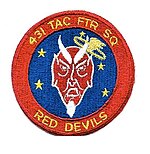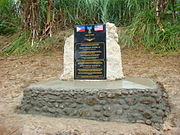| Major Thomas B. McGuire, Jr. | |
|---|---|
 Major Thomas McGuire next to his P-38 "Pudgy (V)" | |
| Born | August 1, 1920 |
| Died | January 7, 1945 (aged 24) |
| Place of birth | Ridgewood, New Jersey |
| Place of death | KIA at Negros Island |
| Place of burial | Arlington National Cemetery |
| Allegiance | United States |
| Service/branch | United States Army Air Forces |
| Years of service | 1941-1945 |
| Rank | Major |
| Unit | 475th Fighter Group |
| Battles/wars | World War II |
| Awards |
Medal of Honor Distinguished Service Cross Silver Star (3) Distinguished Flying Cross (6) Purple Heart (3) Air Medal (15) |
Thomas Buchanan McGuire Jr. (August 1, 1920 – January 7, 1945) was one of the most decorated American combat pilots of World War II. He was the second highest scoring American ace of the war and was awarded the Medal of Honor posthumously. McGuire was memorialized by the renaming of Fort Dix Army Air Force Base in Burlington County, New Jersey, to McGuire Air Force Base in 1948.
Early years[]

Aviation Cadet Thomas B. McGuire.
McGuire was born in Ridgewood, New Jersey, on August 1, 1920. He and his mother moved to Sebring, Florida in the late 1920s and McGuire graduated from Sebring High School in 1938. He enrolled at Georgia Tech and joined Beta Theta Pi fraternity, but left after his third year to join the then-U.S. Army Air Corps in 1941, reporting to a contract flying school in Corsicana, Texas, as an aviation cadet. He later earned his wings after finishing his flight training at Randolph Field, Texas.[1]
World War II[]
First combat[]
During World War II, his first combat assignment was flying patrols over the Aleutian Islands and Alaska flying the Bell P-39 Airacobra while assigned to the 54th Fighter Group. While scoring no aerial victories in the Aleutians, McGuire was able to hone his skills as a pilot. Returning to the United States in December 1942, he married Marilynn Giesler, a student at Incarnate Word College in San Antonio, Texas. In February 1943 he reported to Orange County Airport, California for transition training in the Lockheed P-38 Lightning. In March 1943, he was sent to the South Pacific as a P-38 Lightning pilot with the 49th Fighter Group, Fifth Air Force.

431st Fighter Squadron
Five months later, the 5th Air Force decided to create an entire group, the 475th Fighter Group, of P-38 fighters, at the behest of its commander, the legendary Lt Gen George Kenney. Because he was a natural leader and experienced pilot, McGuire was among those chosen to form the new group. He was assigned to the 431st Fighter Squadron. On August 18, 1943, McGuire was part of a group flying top cover for bombers striking at Wewak, New Guinea. Nearing their target, the fighters were attacked by Japanese aircraft. During the battle, McGuire shot down two Nakajima Ki-43 "Oscars" and one Kawasaki Ki-61 "Tony." On the following day, near the same location, he downed two more Oscars. This established him as an air ace in two days, after undergoing a frustrating year of apprenticeship with no opportunities to engage the enemy.
McGuire's career nearly came to an end on October 17, 1943 when he scrambled from Dubodura, New Guinea to intercept approaching Japanese bombers being escorted by Mitsubishi A6M Zero fighters over Oro Bay, New Guinea. During the ensuing dogfight McGuire observed at least seven Japanese Zero fighters attacking a lone P-38 that was trailing smoke. Without hesitation, McGuire dove into the seven enemy fighters and quickly shot down three. Unfortunately the remaining four Zeros were able to attack McGuire and severely damage his aircraft. With his controls shot out McGuire decided to bail out but as he exited the aircraft he found his parachute harness had snagged on something in the cockpit. From 12,000 ft to 5,000 ft McGuire struggled to free himself from the stricken fighter. Finally McGuire was able to free himself and deploy his parachute only 1,000 ft from certain death. Fortunately he landed safely in the water and was rescued by a PT boat. McGuire suffered a 7.7 mm bullet wound to his wrist and numerous other injuries including some broken ribs. He spent six weeks in the hospital before he returned to his unit. For his actions on this day he was awarded a Silver Star and a Purple Heart.
Combat career[]
McGuire's skill at maneuvering the large twin-engined P-38 was legendary, and he would become one of the top scoring combat pilots in US Air Force history. Had it not been for periodic illnesses and heavy administrative duties as Commander, 431st Fighter Squadron, he might have become the United States’ leading ace. Civilian contractor Charles Lindbergh bunked with him for a time and flew as his wingman on several unauthorized missions, and was credited with one aerial kill. Visitors recalled McGuire ordering Lindbergh around, telling him to run errands as though he were a servant.[2]
McGuire wrote a book on combat tactics for the 5th Air Force. On December 25–26, 1944, He downed at least seven Japanese fighter aircraft in just two days over Luzon, Philippines. With 38 kills to his credit, McGuire was only two victories behind Major Richard I. Bong, the United States Army Air Forces’ all-time top ace.
His last mission[]
On January 7, 1945, McGuire was leading a group of four P-38s - himself, Major Jack Rittmayer (four victories), Captain Edwin Weaver (two victories) and Lieutenant Douglas Thropp (one victory) - on a fighter sweep over northern Negros Island in the central Philippines. Their aim was to gain victories. McGuire desperately wanted to pass Major Richard Bong's score of 40 kills. Descending through cloud cover, McGuire’s flight circled a Japanese airfield at Fabrica and then proceeded to a second airstrip at Manapla (also referred to as Carolina). As they approached Manapla, they were confronted by a lone Ki-43 “Oscar”, which immediately engaged McGuire's flight.
Flying in the number-three position, Lt. Thropp saw the Oscar trying to attack him in a head-on pass. Thropp instinctively broke hard left. The Japanese pilot turned with him and fell into position behind him while firing. Major Rittmayer, flying as Thropp's wingman, turned sharply towards and began firing on the attacker. McGuire saw that the Oscar was being engaged by Rittmayer and turned to face an imminent threat to the flight from the opposite direction. McGuire and his flight had encountered the Japanese pilot, Warrant Officer Akira Sugimoto, who was an instructor pilot with some 3,000+ hours in that type of aircraft. He broke away from Thropp and Rittmayer and turned to find McGuire and his wingman Ed Weaver directly in front of him. Sugimoto was easily able to catch up and attack them from behind.
As Sugimoto approached Weaver from behind, Weaver radioed he was attacked and cut inside of the turn to present a more difficult shot. McGuire eased up on his turn rate in an effort to draw the attacker off of his wingman and onto himself. Sugimoto took the bait and switched his attack to McGuire. As Sugimoto approached from behind, McGuire rapidly increased his turn rate. This extremely dangerous maneuver, performed at only 300 ft (90 m) above the ground, caused McGuire's P-38 to stall. It snap-rolled to an inverted position and nosed down into the ground. He was killed on impact. At the start of the dogfight, McGuire had radioed to keep their auxiliary fuel tanks, as they would need them to reach their main objective in the sweep. Many P-38 pilots believe that this order, which was contrary to standard operating procedures, was the cause of McGuire's death. The auxiliary fuel tank added extra weight and encumbered the aircraft, making it less maneuverable and more prone to stall and spin at low speeds.
After McGuire's crash, Thropp caught up to Sugimoto and fired on him causing enough damage that the Japanese pilot had to make a forced landing a few miles away from where McGuire crashed.
Less than a minute later, another Japanese aircraft, a Ki-84 Hayate "Frank" piloted by Technical Sergeant Mizunori Fukuda, appeared from the nearby airstrip at Manapla and attacked Major Jack Rittmayer in a head-on pass. Rittmayer's P-38 disintegrated from cannon shots and pitched down into a river. Rittmayer was killed on impact. Captain Weaver observed Fukuda's attack and fired at Fukuda, severely damaging his aircraft. Fukuda later crash landed at Manapla, where his fighter was destroyed. Thropp's P-38 was slightly damaged in the action and trailed smoke from one engine. Weaver and Thropp returned to Dulag, Leyte.
McGuire's crash was witnessed by Filipinos who immediately rushed to the scene and secured his body so it would not be captured. In 1947, his remains were recovered and returned to the United States. He was buried with full military honors at Arlington National Cemetery.

Major Thomas B. McGuire Memorial on Negros Island, Republic of the Philippines.
A memorial—placed by aviation archaeologist and former fighter pilot David Mason—stands at McGuire's fatal crash site on Negros Island as a tribute to one of America's greatest fighter pilots.
Honors[]
Military awards and decorations[]
Silver Star with two bronze oak leaf clusters
Distinguished Flying Cross with silver oak leaf cluster
Purple Heart with two bronze oak leaf clusters
Air Medal with two silver and four oak leaf clusters
Presidential Unit Citation with 3 bronze oak leaf clusters
American Defense Service Medal
Asiatic-Pacific Campaign Medal with one silver and two bronze service stars
Other honors[]
- McGuire Air Force Base, New Jersey, January 1948. The base has a P-38 Lightning on static display and the C-17 and KC-10 aircraft flown by the 305 AMW and 514 AMW carry the image of a P-38 in the fin flash of each aircraft's vertical stabilzer.
- Major Thomas B. McGuire Medal of Honor Exhibit: National Museum of the United States Air Force, Wright-Patterson AFB, Ohio.
- National Aviation Hall of Fame, Dayton, Ohio
- Aviation Hall of Fame of New Jersey (Teterboro Airport)
- Georgia Aviation Hall of Fame
- National Medal of Honor Grove, Valley Forge, Pennsylvania
- Florida Medal of Honor Grove
- Georgia Tech Alumni Medal of Honor Garden
- United States and Canadian Military Service display of the Beta Museum at the Beta Theta Pi General Fraternity headquarters in Oxford, Ohio
See also[]
References[]
Notes[]
Bibliography[]
- Berg, A. Scott. Lindbergh. New York: G.P. Putnam's Sons, 1998. ISBN 0-399-14449-8.
- Martin, Charles A. The Last Great Ace: The Life of Major Thomas B. McGuire, Jr. Jacksonville, Florida: Fruit Cove Publishing, 1999. ISBN 0-9667791-0-X.
External links[]
- Tommy McGuire at acesofww2.com
- McGuire Air Force Base Website fact sheet
- McGuire fact sheet from the National Museum of the USAF (includes MOH citation)
- 248th Hiko Sentai: A Japanese "Hard Luck" Fighter Unit {Copyrighted - for reference only}
- "The Last Great Ace" a book about The Life of Thomas B. McGuire written by Charles A. Martin
- "Wingman to the Aces: LT Floyd Fulkerson: Ultimate Wingman" Flight Journal, December 2012
The original article can be found at Thomas McGuire and the edit history here.